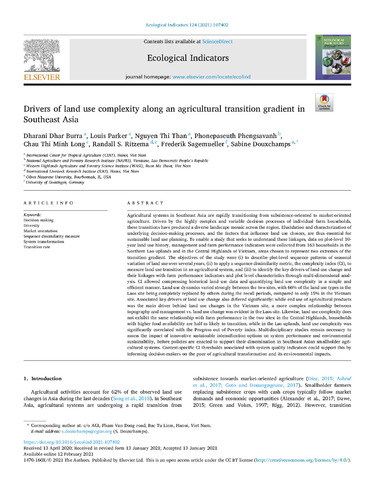Drivers of land use complexity along an agricultural transition gradient in Southeast Asia
Agricultural systems in Southeast Asia are rapidly transitioning from subsistence-oriented to market-oriented agriculture. Driven by the highly complex and variable decision processes of individual farm households, these transitions have produced a diverse landscape mosaic across the region. Elucidation and characterization of underlying decision-making processes, and the factors that influence land use choices, are thus essential for sustainable land use planning. To enable a study that seeks to understand these linkages, data on plot-level 10-year land use history, management and farm performance indicators were collected from 163 households in the Northern Lao uplands and in the Central Highlands of Vietnam, areas chosen to represent two extremes of the transition gradient. The objectives of the study were (i) to describe plot-level sequence patterns of seasonal variation of land use over several years, (ii) to apply a sequence dissimilarity metric, the complexity index (CI), to measure land use transition in an agricultural system, and (iii) to identify the key drivers of land use change and their linkages with farm performance indicators and plot level characteristics through multi-dimensional analysis. CI allowed compressing historical land use data and quantifying land use complexity in a simple and efficient manner. Land use dynamics varied strongly between the two sites, with 66% of the land use types in the Laos site being completely replaced by others during the recall periods, compared to only 15% in the Vietnam
site. Associated key drivers of land use change also differed significantly: while end use of agricultural products was the main driver behind land use changes in the Vietnam site, a more complex relationship between topography and management vs. land use change was evident in the Laos site. Likewise, land use complexity does not exhibit the same relationship with farm performance in the two sites: in the Central Highlands, households with higher food availability are half as likely to transition, while in the Lao uplands, land use complexity was significantly correlated with the Progress out of Poverty index. Multidisciplinary studies remain necessary to assess the impact of innovative sustainable intensification options on system performance and environmental sustainability, before policies are enacted to support their dissemination in Southeast Asian smallholder agricultural
systems. Context-specific CI thresholds associated with system quality indicators could support this by informing decision-makers on the pace of agricultural transformation and its environmental impacts.

